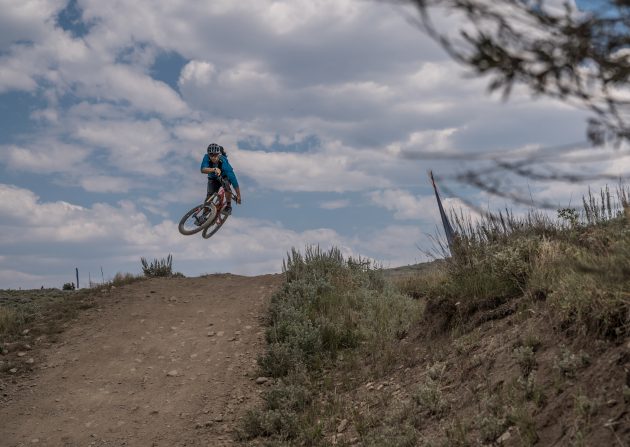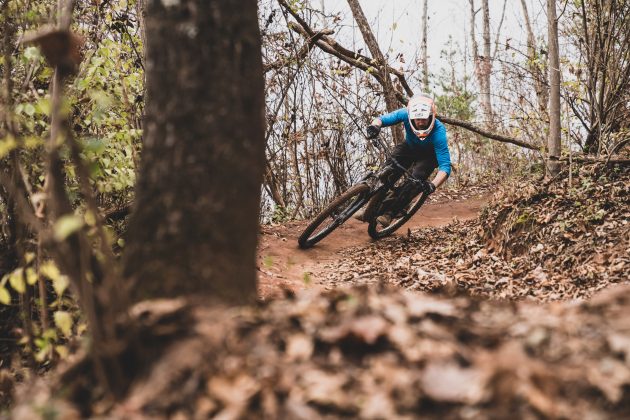In Print: Bike-Park Generation
Originally posted on June 26, 2019 at 0:37 amBy Brett Rothmeyer
The sun is just cracking over the Uintas in Park City, Utah. Main Street is starting to chatter as the doors to cafés open; the wisp of a broom on the sidewalk is overtaken only by the occasional slow-moving vehicle headed up the hill. I had long daydreamed about riding Park City powder. Most of my teenage years were spent sliding sideways on granular, packed, mostly man-made snow in western Pennsylvania and flipping listlessly through the pages of TransWorld Snowboarding. Far-off mountain passes with piles of fluffy white filled my dreams.
It’s a bluebird day in Park City and we are gliding on a chairlift at Deer Valley Resort to the summit to begin a day full of riding. I take a deep breath to absorb a moment I had imagined happening for the better part of two decades. There’s only one problem: no snow. It’s July, and the fact that we’re riding mountain bikes and not sliding on snowboards means conditions are damn near perfect.
***
Since its humble Klunker beginnings, mountain biking has been rooted in going downhill. What began as a by-product of riding bikes that were extremely inefficient at going uphill, the first shuttle runs coincided with the birth of the sport. Whether it was the trails on Mount Tamalpais in Marin County, California, or the steep fire roads of Crested Butte, Colorado, the image of a rider dressed in jeans and a flannel tripod-ing around a dusty corner is synonymous with the early days of mountain biking.
 As the ’80s progressed and the equipment began to be more refined for the terrain, mountain bikers’ obsession with going down did not wane in the slightest. The first decade of mountain biking witnessed a fantastic amount of progression from both man and machine. Grassroots events turned into more-organized races, like the NORBA Nationals series, attracting the best competitors around. Eventually, the UCI (the governing body for professional racing) took note and held the first-ever World Championships of mountain biking in 1990 in Durango, Colorado. Ned Overend won the cross-country race while Greg Herbold led a trio of Americans in a podium sweep of the downhill event.
As the ’80s progressed and the equipment began to be more refined for the terrain, mountain bikers’ obsession with going down did not wane in the slightest. The first decade of mountain biking witnessed a fantastic amount of progression from both man and machine. Grassroots events turned into more-organized races, like the NORBA Nationals series, attracting the best competitors around. Eventually, the UCI (the governing body for professional racing) took note and held the first-ever World Championships of mountain biking in 1990 in Durango, Colorado. Ned Overend won the cross-country race while Greg Herbold led a trio of Americans in a podium sweep of the downhill event.
The following year, the UCI introduced the World Cup, and in 1993 it added downhill to the schedule. American riders like John Tomac, Missy Giove and Mike King would compete with the world’s best on the hardest courses. Even in the early days of downhill, it didn’t take long for the rest of the world to catch on. Courses have since significantly increased in difficulty, and the competitors and bikes have been forced to match. What began as a fringe activity on the dirt tracks of California and Colorado is now arguably the most popular discipline of the sport. Massive sponsorship dollars from companies who live broadcast the events, such as Red Bull, have also helped downhill grow over the last several years.
During the NORBA Nationals years, races were predominantly held at ski resorts to accommodate both the cross-country and downhill events. Many of these resorts left trail access open to riders during the summer months, and a lot of them started offering lift service as well. Park City’s Deer Valley Resort was a regular stop on the NORBA calendar that saw the potential in providing year-round lift access to the outdoor community. Extending to over 70 miles of trail and adding four new professionally built flow trails, Deer Valley Resort has become a destination for mountain bikers.
“This town has had a long history of investing in and improving the trail infrastructure, for nearly 30 years,” remarks Jim Powell of the Park City Chamber of Commerce. The efforts have been noticed: They’ve received awards such IMBA’s gold-level certification for mountain biking for the entire town’s support and trail system.
Deer Valley doesn’t just offer top-notch riding and lift access; all of the amenities that are available during ski season are offered all summer long as well. Recognizing that many of the same families that spend their winters skiing at the resort are the same families that spend their summers riding the trails, there are schools and camps for kids during the summer months, and it doesn’t take long to notice the effects on the next generation when out riding the trails. The sight of groms launching giant doubles and descending at high speeds can be both inspiring and terrifying.
Just down the road from Deer Valley is Park City Resort, offering riders lift access to everything from gravity-oriented flow trails to legacy tracks and one of the area’s more popular routes, the Wasatch Crest. While Park City has a copious amount of riding to offer mountain bikers, it is certainly not the only ski resort offering the mountain bike experience. Locations like Whistler, British Columbia; Mammoth Mountain, California; and Crested Butte have all been in the mountain bike game for quite some time.
On the East Coast, ski resorts have found quite the ally in mountain biking. Winters can be fickle for many of the ski towns up and down the eastern portion of the country, and the inclusion of bike parks and all-summer lift access has gone a long way in helping resorts keep the doors open. In the small town of East Burke, Vermont, mountain bike tourism has become the main source of revenue for the sleepy ski town. Home to the Kingdom Trails and Victory Trails, Burke Mountain sits in what is perhaps the epicenter of destination mountain biking in the Northeast.

Local rider and trail builder Knight Ide saw potential in the topography of the region. Starting with the illegal trails already built at the top of Burke Mountain, Ide and his close friends began laying groundwork. Ide spent time at larger resorts and saw what places like Whistler were creating; he aimed to build more gravity-oriented trails in the woods of East Burke. He used his tools and skills as a mason and contractor to construct the Kingdom’s first machine-built trail, Kitchel. It offers riders a one-way ticket to the bottom of Darling Hill via berms and doubles, giving riders a taste of resort-style riding.
Since shutting down riding on Ide’s original outlaw routes, Burke has asked him to return to the mountain to help them design and build downhill-oriented trails, allowing them to open their lifts to riders. Ide and a small crew finished what they started: They added Knight Slayer and the newly renamed Rude Awakening, after EWS champion Richie Rude. Burke hopes the prime location will help to capitalize on the increasing number of riders visiting the area every summer.
Thanks to builders like Ide, the Kingdom Trails have shown that flow-style jump lines are not reserved just for ski resorts.
“I like to fly through the air,” Ide remarked during a recent episode of “The Vermont Outdoors Podcast.” “I want to build trails with jumps and have fun.” Ide is clearly not the only one who feels this way. All over the country, trail systems are adding more and more of these “bike park-esque” features. Based off of the work they did in Vermont, Ide and his crew have been hired to build similar trails for other communities. Most recently, they added several sections of downhill and flow trail to Baker Creek Preserve in Knoxville, Tennessee.
One only needs to look around to see where the future of the sport is headed. The current generation of riders has picked up the torch and gone on to push the terrain and abilities to unfathomable levels. Events like Red Bull Rampage and Dark Fest show just how far we have come in such a short amount of time. From drifting balloon tires around gravel bends to sending 50-foot drops off a cliff, right now the possibilities seem limitless. With access to bike parks and technically challenging terrain like never before, it may be a safe wager to say the future of mountain biking is likely to be more rad and allow us to go bigger than we can even think possible.
***
As we plummet down the first section of Tsunami at Deer Valley Resort and my tires detach from the earth, whatever part of me that wished it was winter fades into the background. The sensation of surfing two wheels through the woods dodging trees is decidedly similar to snowboarding, and flowing down the slopes of a mountain amplifies that. As we hit the bottom and head to the lift for another run, I look around at all the kids waiting to get on, clad in full-face helmets, yammering on about how high they jumped or how fast they had taken a corner. The future is in good hands.